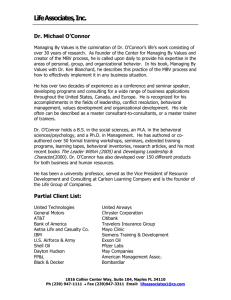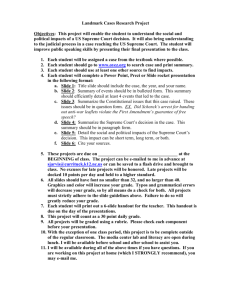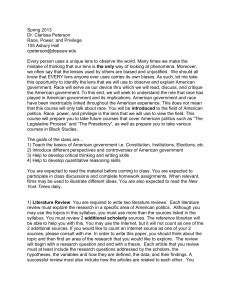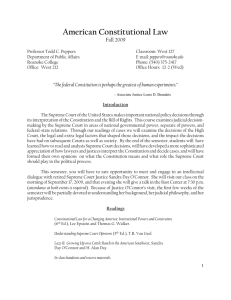AP* United States Government and Politics 2014
advertisement
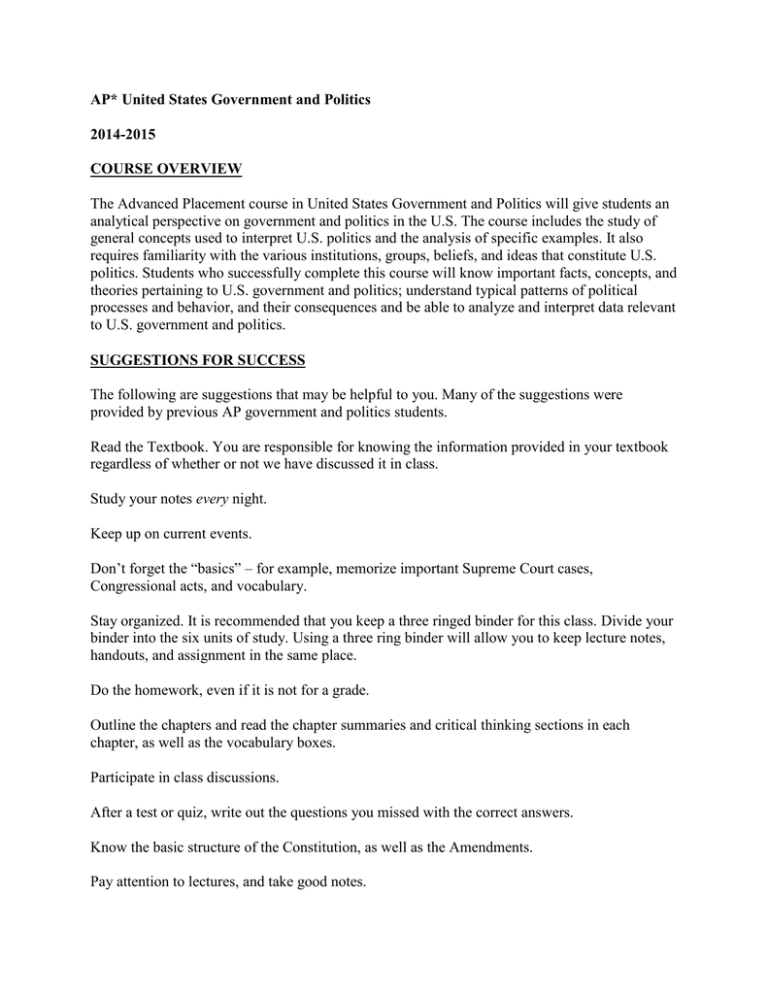
AP* United States Government and Politics 2014-2015 COURSE OVERVIEW The Advanced Placement course in United States Government and Politics will give students an analytical perspective on government and politics in the U.S. The course includes the study of general concepts used to interpret U.S. politics and the analysis of specific examples. It also requires familiarity with the various institutions, groups, beliefs, and ideas that constitute U.S. politics. Students who successfully complete this course will know important facts, concepts, and theories pertaining to U.S. government and politics; understand typical patterns of political processes and behavior, and their consequences and be able to analyze and interpret data relevant to U.S. government and politics. SUGGESTIONS FOR SUCCESS The following are suggestions that may be helpful to you. Many of the suggestions were provided by previous AP government and politics students. Read the Textbook. You are responsible for knowing the information provided in your textbook regardless of whether or not we have discussed it in class. Study your notes every night. Keep up on current events. Don’t forget the “basics” – for example, memorize important Supreme Court cases, Congressional acts, and vocabulary. Stay organized. It is recommended that you keep a three ringed binder for this class. Divide your binder into the six units of study. Using a three ring binder will allow you to keep lecture notes, handouts, and assignment in the same place. Do the homework, even if it is not for a grade. Outline the chapters and read the chapter summaries and critical thinking sections in each chapter, as well as the vocabulary boxes. Participate in class discussions. After a test or quiz, write out the questions you missed with the correct answers. Know the basic structure of the Constitution, as well as the Amendments. Pay attention to lectures, and take good notes. Form study groups. Manage your time wisely. Use a planner to keep track of important dates and deadlines. You will frequently get reading and homework assignments a week or more in advanced. Use your planner to remember when assignments are due. GRADING POLICIES AND PROCEDURES This course will utilize a number of activities including textbook readings, supplemental interpretive readings, authentic assessments, writing, and discussion. Some activities will be graded and other will not however participation in all activities is required in order to receive full credit in the course. At minimum, you should expect the following evaluative measure: Essays on subjects covered in the course will be given bi-weekly. These will be timed as though they were part of the AP exam. Late essays will not be accepted. Participation in class is mandatory. Everyone should be able to contribute to class discussion at least once per class session. Quizzes and tests will be given throughout the course. Most quizzes will be announced however some may not. All tests will be announced and will be timed as though they were part of the AP exam. Because the AP exam will expect you to analyze and interpret the entire content of the course, rather than memorizing facts, it is expected that you are familiar with all content areas previously studied at all times. There is no retesting in AP. Extra credit may be offered occasionally for participation in activities outside of class. Examples can include participating in a campaign, working at a polling place or attending a lecture. Extra credit is rare and will only be offered on a class wide basis (meaning no individual extra credit assignments will be assigned). Extra credit must be completed by the date assigned. Homework is due at the beginning of the period. No late work will be accepted. It is your responsibility to get any work that you miss when you are absent. You will be given time to make-up your work; however it will not be accepted after the deadline. Any work that is due on the day you were absent will be due on the first day of class upon your return. Tests will be made up on the first scheduled advisory period. This course grade will be determined by total point performance achieved by the student on class projects, test, quizzes, handouts, oral presentations, debates, essays, etc. The Donegal School District Grading Scale will be used. SPECIFIC ASSESSMENTS IN CLASS: HOMEWORK, EXAMS, QUIZZES, ESSAYS AND CURRENT EVENTS: There will reading every night- an average of 5-7 pages in the text, with occasional handouts and other supplemental reading. Students are encouraged to bring their textbook to class every day. Students are also encouraged to have a 3-ring binder that they must bring to class. Participation in class discussion is mandatory. Everyone should be able to contribute to class discussion at least once per class session. There will be pop quizzes that will include paragraph-style writing, multiple choice timed quizzes on reading homework, lecture and homework assignments. 1-2 page typed essays will accompany selected units studied. These essays are formal, collegestyle essays that include a 5-paragraph style format with Chicago-style citations required. Students will also be expected to frequently write free response questions (FRQ), in-group work or on exams. All FRQ’s will be based on the format presented by the AP Government exam. Students will examine numerous charts, graphs, and political cartoons from the overheads and power points included with the text (O’Connor), as well as handouts taken from other sources deemed relevant by the instructor. Exams will follow each unit. Each exam will consist of multiple-choice and essay questions. Exams will cover material from the textbook, homework, and class discussion. Knowledge of contemporary political events is essential for the analytical focus that must be exhibited in essays. It is highly recommended that students expose themselves to as many of the following sources as possible: major newspaper (i.e., Washington Post, National Weekly, New York Times and Christian Science Monitor); major news magazines; television news programs (i.e. “ News Hour with Jim Lehrer,” “Nightline,” even the Daily Show) C-SPAN; major network evening news programs; and public radio-NPR Text: O’Connor, Karen, and Larry J. Sabato. American Government: Roots and Reform, 10th. Edition. Longman. New York. 2009 Pearson’s Online Solutions: Online Textbook and Activities Supplemental: Ladd, Everett and Serow, Ann. American Polity.5th. Edition. Lanahan. Baltimore. 2011 Local and metropolitan newspapers and news magazines, television and the Internet COURSE OUTLINE I. Constitutional Underpinnings (8 Days) · Roots of American Government Political Culture and Ideologies Declaration of Independence Articles of Confederation: Strengths and Weaknesses The Constitution: Bundle of Compromises, Separation of Powers, Checks and Balances Amending the Constitution Federalism Readings: O’Connor, Chapter 1 - “The Political Landscape” O’Connor, Chapter 2- “The Constitution” O’Connor, Chapter3- “Federalism The Declaration of Independence The United States Constitution Federalist Papers #’s 10 & 51 Activities: Intro to Current Events Terms to Know Quote Analysis: “If men were angels …” Locke and Hobbes/ Social Contract Theory/ The Declaration of Independence (Flow Chart) Articles of Confederation and Constitution Analysis (Venn diagram) Constitution Scavenger Hunt Amendment Search and Types (Graphic Organizer) Supreme Court Reports: McCulloch v. Maryland (1819), Gibbons v. Ogden (1824) Special Focus Reading: Federalism Discussion: Medical Marijuana, Same Sex Marriage Formal Assessments Amendments Quiz Unit Test: 40 Multiple Choice, 1 Free Response Question. Timed! II. Civil Rights and Civil Liberties (8 Days) Civil Liberties and Civil Rights 14th. Amendment: Incorporation Doctrine/Selective Incorporation First Amendment Guarantees Church and State Speech, Press, Assembly, and Petition Crime and Due Process Civil Rights Movement: Supreme Court Cases and Federal Legislation Readings: O’Connor, Chapter 5: Civil Liberties O’Connor, Chapter 6: Civil Rights Supreme Court Cases (Civil Liberties & Civil Rights) Activities: Current Events; Terms to Know; Supreme Court Glogs Capital Punishment Debate; Scott, Plessy and Brown (Graphic Organizer) and Discussion Civil Rights Legislation: Timeline Formal Assessments Supreme Court Case Glog Unit Exam: 40 Multiple Choice, 1 Free Response Question. Timed! III. Institutions of the National Government: The Congress, The Presidency, The Bureaucracy, and The Federal Courts (30 Days) A. CONGRESS (8of 30 Days) Bicameral Congress The House and Senate Organization of Congress: Leadership How a Bill Becomes a Law: Filibuster, Cloture, and Political Parties The Role of Committees: Standing, Rules, Special, Joint, and Conference Powers of Congress Theories of Representation and Decision Making Congress vs. Other Branches of Government (Checks and Balances) Readings: O’Connor, Chapter 7 – “Congress” Waterman, Richard: Presidential Signing Statements: The Constitutional Versus the New Government Models Activities: Current Events Terms to Know Difference Between the House and the Senate: Graphic Organizer Short Video: “How a Bill Becomes a Law” Flow Chart: The Impeachment Process Analyzing approval ratings of Congress and individual representatives to determine re-election results Assessments Essay: Congressional Profile Chapter Exam: 40 Multiple Choice, 1 Free Response. Timed! B. THE PRESIDENCY (8 of 30 Days) Roots of the Single Executive Constitutional Qualifications and Terms of Office Presidential Succession and Disability The Roles and Powers of the Presidency Expansion of Presidential Power: The Imperial Presidency Use of Media and the White House: Overview of Foreign Policy and the President Presidential Election Process: The Electoral College Presidency vs. The Other Branches of Government Readings: O’Connor, Chapter 8 – “The Presidency” Todd & Gawiser: How Barak Obama Won Andrade, Lydia: Going Public and the Problem of Avoiding Presidential/Congressional Compromise Schiffer and Currier: War Powers, International Alliances, the President and Congress Activities: Current Events Terms to Know Chart of Presidential Powers (Duties, Description of Pres. Powers, Current Examples); Essay: How modern Presidents have expanded their powers of the executive office. Power Point: Presidential Elections Assessments Presidential Election Power Point Chapter Test: 40 Multiple Choice, 1 Free Response Question. Timed! C. BUREAUCRACY / BUDGET (6of 30 Days) Structure and Growth of Bureaucracy Bureaucrats and How Bureaucracies Work Relationship Between Bureaucracies and the Executive and Legislative Branches The Government and the Economy The Budget Process · Readings: O’Connor, Chapter 9– “The Executive Branch and The Federal Bureaucracy” O’Connor, Chapter 18 – “Economic Policy” Wilson, James: Bureaucracy Andrade, Lydia: Interest Group Interconnections Activities: Current Events Terms to Know Timeline: Development of the Federal Bureaucracy Graphic Organizer: Types of Bureaucracies Research/Discussion: Are Bureaucracies Necessary? Federal Budget Analysis: How is Money Allocated and Spent? Assessments Unit Test: 40 Multiple Choice Questions & 1 Free Response Question. Timed D. THE JUDICIARY (8 of 30 Days) Roots of the Federal Judiciary Judicial Review: Marbury v. Madison The American Legal System The Federal Court System Nomination and Confirmation of Federal Judges The Supreme Court & Judicial Philosophy Landmark Supreme Court Cases Readings: O’Connor, Chapter 10 – “The Judiciary” Yacobucci, Peter: The Tensions of Judicial Appointments Landmark Supreme Court Cases Federalist 78 Activities: Current Events Terms to Know A Day in the Life: The Supreme Court in the Life of Students Analysis: District Court appointees by race, gender, and ethnicity and determine ruling outcomes Glog: Landmark Supreme Court Cases How the President affects the Federal Judiciary Assessment Supreme Court Case Glog Chapter Exam: 40 Multiple Choice Questions & 1 Free Response Question. Timed! IV. Political Beliefs And Behaviors (8 Days) Political Socialization The Political Spectrum/Political Ideology Public Opinion and Polling Citizen’s Attitude Toward Government Effects of Public Opinion on Government and Politics Readings: O’Connor, Chapter 11 – “Political Socialization and Public Opinion” Moore, David: The Opinion Makers Activities: Current Events Terms to Know Political Socialization: Graphic Organizer Debate: Should Civics Be Taught In American High Schools? Political Spectrum Questionnaire: Where Do You Stand? Poll Analysis: Written Report Public opinion and Media Assessments Poll Analysis Report Unit Exam: 40 Multiple Choice Questions & 1 Free Response Question. Timed! V. Political Parties, Interest Groups, And Mass Media (12 Days) A. POLITICAL PARTIES Roots of the Two Party System Minor Parties in the Two Party System Party Realignment/Critical Elections Functions of Political Parties Party Organization The Party in Government The Party in the Electorate Dealignment B. Voting and Elections Patterns in Voter Turnout Patterns in Voter Choice Types of Elections Election Process Political Campaigns Presidential and Congressional Elections Electoral College (Review) The Campaign Process Campaign Finance: The Rules of the Game The Main Event: The 2008 Presidential Campaign Readings O’Connor, Chapter 12: Political Parties O’Connor, Chapter 13: Voting and Elections O’Connor, Chapter 14: The Campaign Process Burnham, Walter: Critical Elections and the Mainsprings of American Politics Rothenberg, Stuart: Is 2008 a Realigning Election? Numbers Offer Some Clues Activities Current Events Terms to Know Timeline: U. S. Two Party System Graphic Organizer: Types of Third Parties Party Identification Analysis: Determine trends in Americans who identify with Democrats, Republicans and Independents 1952-2008. Political Party Brochure Election Process Timeline 2008 & 2010 Congressional Elections Analysis Debate- Campaign Finance: Freedom of Speech or License to Corrupt? Assessment Political Party Brochure Party Identification Analysis Report Congressional Elections Analysis Report 2008 Presidential Campaign Analysis Unit Exam: 40 Multiple Choice Questions & 1 Free Response Question. Timed! C. The Media 300 Years of News Media in the United States Print Media Radio News Television News Current Media Trends Rules Governing the Media The Media and Politics Media Influence and Bias Public Perception of the Media Readings: O’Connor, Chapter 15 – “The Media” Mutz, Diane: How the Media Divides Us Peterson, Bradley: Strange Bedfellows Activities: Current Events Terms to Know How Television Transformed Politics: Video Nixon and Kennedy Watch and Compare Two Television News Shows: Graphic Organizer Debate: Are the Media Biased? Interpret and Discuss Political Cartoons Video clip: The Media and Politics Assessment Essay: Are the Media Biased Political Cartoon Analysis Television News Comparison Paper Chapter Test: 40 Multiple Choice Questions & 1 Free Response Question. Timed! D. Interest Groups Roots of the American Interest Group System Types of Interest Groups The Development of American Interest Groups What Do Interest Groups Do? : Lobbying, Election Activities Soft Money and Hard Money PAC’s Regulation of Interest Groups, Lobbyists, and PAC’s Activities Current Events Terms to Know Interest Group Research: Tactics, Techniques, and Influence- Oral report Class Debate: Are PAC’s Out of Control Assessment Oral Report on Interest Groups Chapter Exam: 40 Multiple Choice Questions & 1 Free Response Question. Timed! VI. PUBLIC POLICY (8 Days) Public Policy Making Process: Who Sets The Agenda Implementation of Policy Domestic Policy Income Security and Health Care Policies Energy and Environmental Policy Economic Policy Government Involvement in the Economy Government Stabilization of the Economy The Budget Process Military v. Domestic Expenditures (“Guns and Butter”) Foreign and Defense Policy History of U.S. Foreign Policy and Defense The U. S. as a World Power Unilateralism or Multilateralism Readings: O’Connor, Chapter 17: Domestic Policy O’Connor, Chapter 18: Economic Policy O’Connor, Chapter 19: Foreign Policy Cohen, Steven: Understanding Environmental Policy Phillips, Kevin: Bad Money Activities: Current Events; Terms to Know; Data Analysis: Unemployment Rates by State and Determine how it Correlates to Governmental Policy. Debate: Economic Stimulus Payments Examine State Health Care Insurance Plans: Pros and Cons-Graphic Organizer Debate: Should the United States Pull out of the United Nations Assessment Data Analysis Report State Health Care Examination Report Unit Exam: 40 Multiple Choice Questions, 1 Free Response Question. Timed! Review (6 Days) Review for AP* U.S. Government and Politics Exam. Sample AP* U. S. Government and Politics Tests. Timed!
